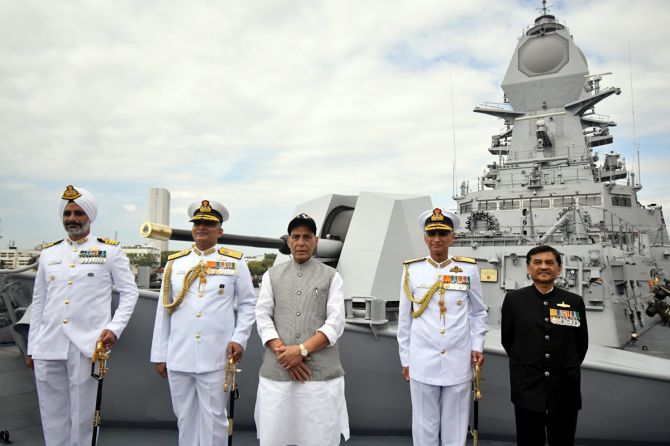INS Vishakapatnam's ground attack and anti-ship capabilities are achieved through a bank of BrahMos cruise missiles that can be fired at targets up to 295 km away.
Ajai Shukla reports.

The Indian Navy commissioned its tenth destroyer on Sunday, the 7,400-tonne Indian Navy Ship (INS) Visakhapatnam. This is the lead vessel in a new class of four guided missile destroyers that Mazagon Dock Ltd, Mumbai (MDL), is building under Project 15B for Rs 35,800 crore (Rs 358 billion) -- or Rs 8,950 crore (Rs 89.50 billion) per vessel.
The next three Project 15B destroyers -- INS Mormugao, INS Imphal, INS Surat -- will join the navy's fleet at one-year intervals.
The tradition of naming the navy's destroyers after Indian cities began with Project 15 -- which yielded INS Delhi in 1997, INS Mysore in 1999 and INS Mumbai in 2001.
This was followed by Project 15A, with Prime Minister Narendra Damodardas Modi commissioning the lead warship, INS Kolkata, at MDL on August 16, 2014. INS Kochi followed in 2015 and INS Chennai in 2016.
However, even after all four destroyers of Project 15B are commissioned, the navy will have to make do with just 10 destroyers, since three old Rajput-class vessels, which were bought from Moscow in the mid-1980s, are on the verge of being decommissioned from service.
In contrast, China's navy -- the People's Liberation Army Navy, or PLA(N) -- has a fleet of 42 destroyers.
These include four massive 13,000-tonne Renhai-class cruisers known as the Type 055; 21 modern 7,500-tonne Luyang III-class destroyers known as the Type 052; six older 7,000-tonne Luyang II-class destroyers known as the Type 052C; and 11 older and less capable destroyers of the Type 051C, 052B, 051B, 052 and the Soviet-era Sovremenny-class.
Undeterred by the PLA(N)'s overwhelming numerical advantage, Defence Minister Rajnath Singh sharply criticised China, without naming it, for eroding the 'rule-based and stable maritime order' and 'freedom of navigation and security of sea lanes'.
Upholding the 1982 United Nations Convention on the Law of the Sea as the basis for good order at sea, Singh said, 'Some irresponsible nations, for the sake of their narrow partisan interests, keep on giving new and inappropriate interpretations to these international laws from hegemonic tendencies. These arbitrary interpretations create obstacles in the path of a rule-based maritime order.'
'We envision a rule-based Indo-Pacific, with freedom of navigation, free trade and universal values, in which the interests of all the participating countries are protected,' he added.
The defence minister appreciated the navy's self-reliance efforts, pointing out that 39 of the 41 warships and submarines on order, including the first indigenous aircraft carrier, INS Vikrant, are being built in Indian shipyards.
INS Visakhapatnam, which has a total complement of about 315 personnel, will be the navy's most potent warship. It is propelled by four gas turbines that allow it to travel in excess of 30 knots (55 km per hour).
The warship incorporates stealth features, with a reduced radar cross-section (RCS) achieved through efficient shaping of hull, full beam superstructure design, plated masts and use of radar transparent materials on exposed decks.
Its weapons and sensor suite is world-class, with protection against enemy aircraft and incoming anti-ship missiles being provided out to 70 km by the eponymous Indo-Israeli Medium Range Surface-to-Surface Missile (MR-SAM), coupled with the Multi-Function Surveillance and Threat Alert Radar (MF-STAR).
The destroyer's ground attack and anti-ship capabilities are achieved through a bank of Indo-Russian BrahMos cruise missiles that are fired through vertical launch canisters to targets up to 295 km away. The 76 mm main gun is built at Bharat Heavy Electricals Ltd, Haridwar.
Protection against submarines is provided by indigenous rocket launchers, torpedo launchers and anti-submarine warfare (ASW) helicopters. The ship is equipped with nuclear, biological and chemical warfare protective equipment, with its entire requirement of air being filtered through NBC filters.
INS Visakhapatnam has achieved a 75 per cent indigenisation level through an indigenous combat management system, rocket and torpedo launchers, and digitised control systems such as an integrated platform management system (IPMS), automated power management system, foldable hangar doors, helo traversing system, close-in weapon system and bow mounted sonar.
Even the DMR 249A warship-grade steel that the Visakhapatnam is built from has been indigenously manufactured by the Steel Authority of India Ltd.












 © 2025
© 2025